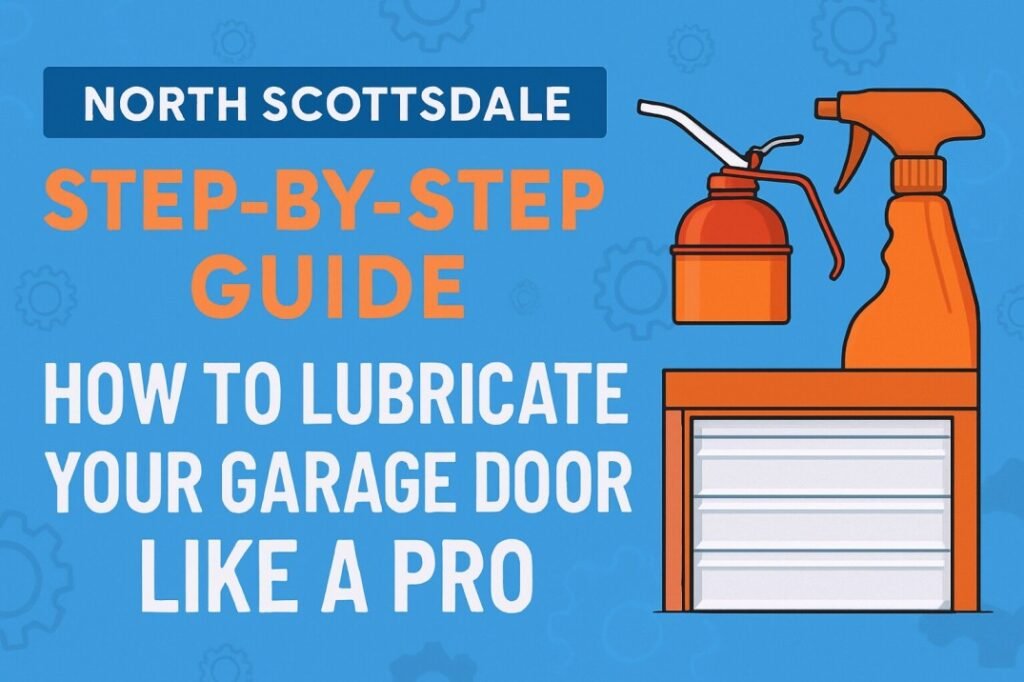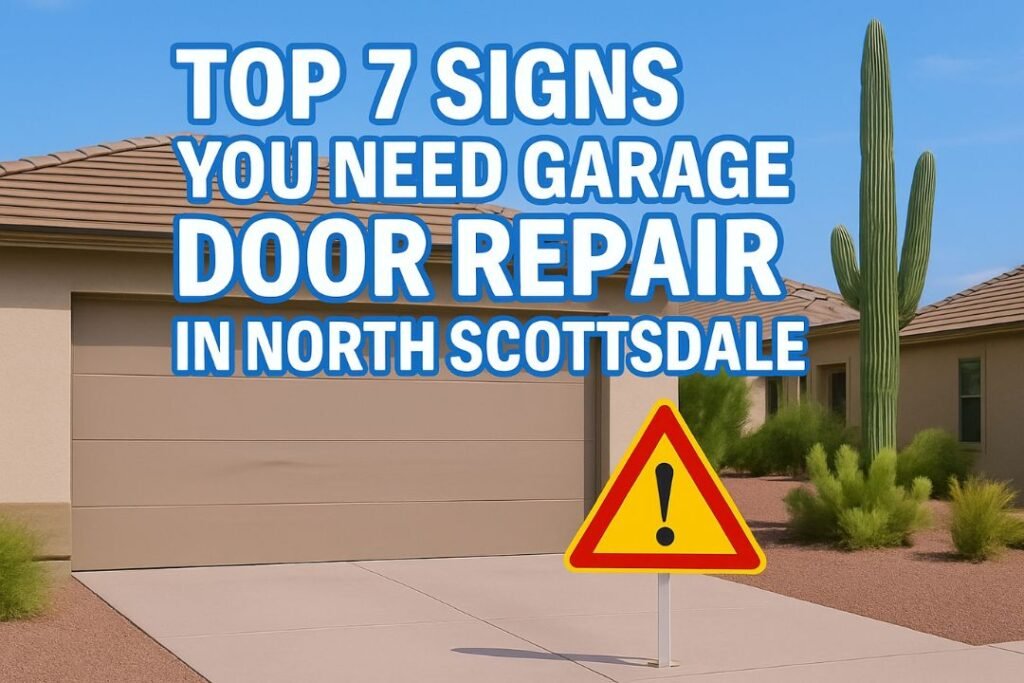
North Scottsdale Garage Door Lubrication Checklist
Use this interactive tool to ensure you lubricate your garage door properly. Check off each step as you complete it!
Great Job!
Your garage door should now operate smoothly. Remember to repeat this every 6 months in North Scottsdale's climate.
If you still hear noises or have issues, you may need professional service:
Contact Garage Door ExpertsIs your garage door making squeaking, grinding, or popping noises? These sounds aren’t just annoying—they can signal that your garage door components are wearing out faster due to friction. Regular lubrication is one of the easiest and most cost-effective ways to keep your garage door running smoothly and extend its lifespan.
In this step-by-step guide, we’ll walk you through how to lubricate your garage door like a pro, ensuring quiet operation and preventing costly repairs. Whether you’re in North Scottsdale’s dry climate or just looking for expert maintenance tips, this guide has you covered.
Why Lubricating Your Garage Door Matters
Before diving into the steps, let’s discuss why garage door lubrication is essential:
✅ Reduces Friction – Metal-on-metal contact wears down rollers, hinges, and tracks over time. ✅ Prevents Rust – Arizona’s heat and dust can accelerate corrosion; lubrication protects metal parts. ✅ Quiets Operation – No more loud squeaks or grinding noises when opening/closing. ✅ Extends Lifespan – Well-maintained garage doors last longer and require fewer repairs. ✅ Improves Efficiency – A smooth-running door puts less strain on the opener motor.
Neglecting lubrication can lead to:
-
Broken springs
-
Worn-out rollers
-
Track misalignment
-
Motor burnout
Now, let’s get into the step-by-step process.
Step 1: Gather the Right Tools & Lubricants
You’ll need:
-
Garage door lubricant (avoid WD-40—it’s a degreaser, not a long-term lubricant)
-
Best options: White lithium grease, silicone-based spray, or a dedicated garage door lubricant.
-
-
Clean rags or paper towels (for wiping excess grease and dirt)
-
A ladder (if your door is tall)
-
A stiff brush or old toothbrush (for cleaning tracks)
-
Safety gloves & glasses (optional but recommended)
Step 2: Inspect Your Garage Door Components
Before applying lubricant, check for:
-
Rust or corrosion on hinges, rollers, and tracks
-
Dirt and debris buildup in the tracks
-
Worn-out rollers (if they’re cracked or chipped, they may need replacement)
-
Loose hardware (tighten any bolts or screws)
If you notice severe damage, consider calling a North Scottsdale garage door repair professional before proceeding.
Step 3: Clean the Tracks & Rollers
Dirt and grime can reduce lubrication effectiveness. Here’s how to clean:
-
Wipe down the tracks with a damp rag to remove dust and cobwebs.
-
Use a stiff brush to scrub away stubborn debris inside the tracks.
-
Check the rollers—if they’re dirty, wipe them down before lubricating.
(Pro Tip: Avoid using water near electrical components like the garage door opener.)
Step 4: Lubricate the Moving Parts
Now, let’s apply lubricant to the key components:
A. Rollers
-
If nylon rollers: Lightly lubricate the bearings (excess grease attracts dirt).
-
If metal rollers: Apply lubricant to the axle and roller edges.
B. Hinges
-
Apply lubricant to each hinge’s pivot points.
-
Open and close the door a few times to work in the lubricant.
C. Tracks
-
Lightly spray the inside of the tracks (avoid over-lubricating, as it can attract dust).
D. Springs (Caution!)
-
Extension springs: Apply a small amount of lubricant to the coils.
-
Torsion springs (above the door): These are under high tension—if unsure, skip or call a pro.
E. Lock & Latch Mechanism
-
Spray a small amount of lubricant into the lock and work the key in/out to distribute it.
(Pro Tip: Wipe away excess lubricant to prevent dripping and dirt buildup.)
Step 5: Test Your Garage Door
After lubrication:
-
Manually lift and lower the door to ensure smooth movement.
-
Operate the automatic opener to check for noise reduction.
-
Listen for unusual sounds—if grinding persists, a part may need replacement.
How Often Should You Lubricate Your Garage Door?
In North Scottsdale’s dry climate, garage doors should be lubricated:
-
Every 6 months (minimum)
-
Every 3-4 months if you use the door frequently or notice squeaking
Common Lubrication Mistakes to Avoid
❌ Using WD-40 – It’s a temporary fix that evaporates and attracts dust. ❌ Over-lubricating – Excess grease collects dirt and grime. ❌ Ignoring worn parts – Lubrication won’t fix broken rollers or springs. ❌ Skipping cleaning – Dirt reduces lubricant effectiveness.
When to Call a Professional
While DIY lubrication helps, some issues require expert attention:
-
Broken or sagging springs (dangerous to handle yourself)
-
Misaligned tracks
-
Garage door opener malfunctions
-
Excessive noise after lubrication
If you’re in North Scottsdale and need professional garage door maintenance, consider hiring a local expert for a tune-up.
Final Thoughts
Lubricating your garage door is a quick, easy task that saves money and prevents major repairs. By following this guide, you’ll keep your door running smoothly, quietly, and efficiently—even in Arizona’s harsh climate.
Need help with garage door maintenance in North Scottsdale? Contact a trusted local technician for professional service!
FAQs
Q: Can I use motor oil to lubricate my garage door? A: Not recommended—it’s messy and attracts dust. Stick to silicone or lithium-based lubricants.
Q: Why is my garage door still noisy after lubrication? A: Worn rollers, loose hardware, or track misalignment may be the issue. Inspect or call a pro.
Q: How do I know if my rollers need replacing? A: If they’re cracked, chipped, or make grinding noises even after lubrication, it’s time for new ones.
By following these steps, you’ll keep your garage door in top shape for years to come. Happy lubricating! 🚪🔧


